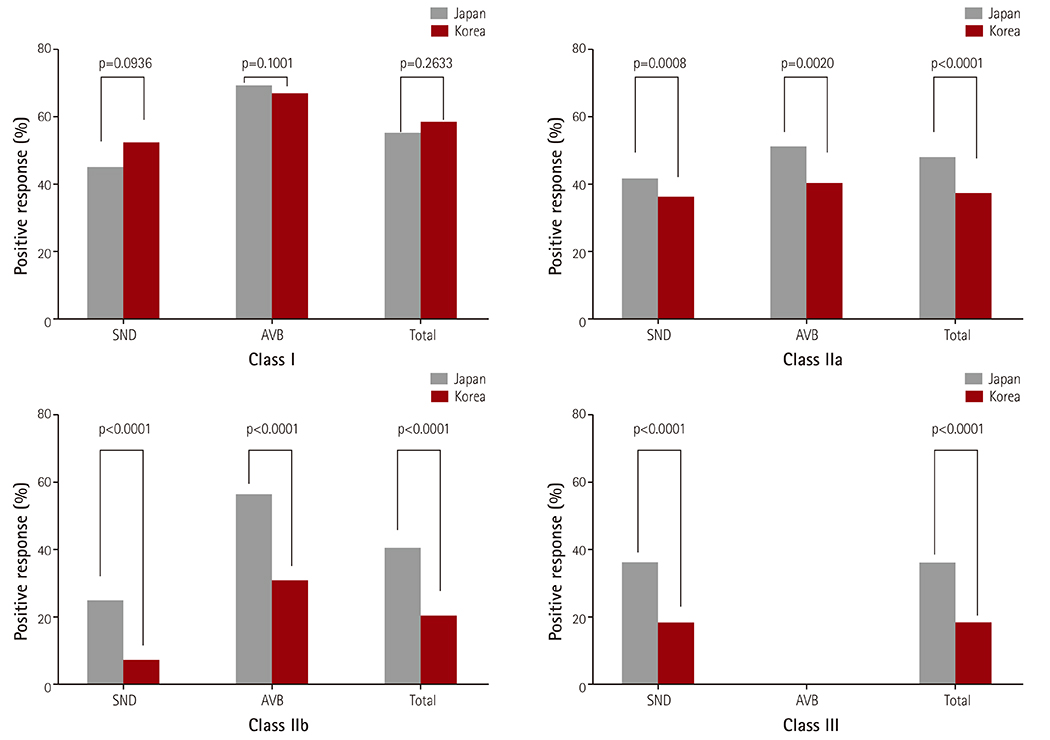Korean Circ J.
2016 Sep;46(5):654-657. 10.4070/kcj.2016.46.5.654.
Differences between Korea and Japan in Physician Decision Making Regarding Permanent Pacemaker Implantation
- Affiliations
-
- 1The Catholic University of Korea, Seoul, Korea. Tairho@catholic.ac.kr
- 2Virginia Mason Medical Center, WA, USA.
- 3Gimhae Jungang Hospital, Busan, Korea.
- 4Takeda Hospital, Kyoto, Japan.
- KMID: 2389622
- DOI: http://doi.org/10.4070/kcj.2016.46.5.654
Abstract
- BACKGROUND AND OBJECTIVES
The number of permanent pacemakers (PPMs) implanted in patients in Japan and Korea differs significantly. We aimed to investigate the differences in decision making processes of implanting a PPM.
MATERIALS AND METHODS
Our survey included 15 clinical case scenarios based on the 2008 AHA/ACC/HRS guidelines for device-based therapy of cardiac rhythm abnormalities (class unspecified). Members of the Korean and Japanese Societies of Cardiology were asked to rate each scenario according to a 5-point scale and to indicate their decisions for or against implantation.
RESULTS
Eighty-nine Korean physicians and 192 Japanese physicians replied to the questionnaire. For the case scenarios in which there was a class I indication for PPM implantation, the decision to implant a PPM did not differ significantly between the two physician groups. However, the Japanese physicians were significantly more likely than the Korean physicians to choose implantation in class IIa scenarios (48% vs. 37%, p<0.001), class IIb scenarios (40% vs. 19%, p<0.001), and class III scenarios (36% vs. 18%, p<0.001). These results did not change when the cases were categorized based on disease entity, such as sinus node dysfunction and conduction abnormality.
CONCLUSION
Korean physicians are less likely than Japanese physicians to favor a PPM implantation when considering a variety of clinical case scenarios, which probably contributes to the relatively small number of PPMs implanted in patients in Korea as compared with those in Japan.
MeSH Terms
Figure
Reference
-
1. Mond HG, Proclemer A. The 11th world survey of cardiac pacing and implantable cardioverter-defibrillators: calendar year 2009-A World Society of Arrhythmia's project. Pacing Clin Electrophysiol. 2011; 34:1013–1027.2. Epstein AE, DiMarco JP, Ellenbogen KA, et al. ACC/AHA/HRS 2008 Guidelines for Device-Based Therapy of Cardiac Rhythm Abnormalities: a report of the American College of Cardiology/American Heart Association Task Force on Practice Guidelines (Writing Committee to Revise the ACC/AHA/NASPE 2002 Guideline Update for Implantation of Cardiac Pacemakers and Antiarrhythmia Devices) developed in collaboration with the American Association for Thoracic Surgery and Society of Thoracic Surgeons. J Am Coll Cardiol. 2008; 51:e1–e62.3. JCS Joint Working Group. Guidelines for Non-Pharmacotherapy of Cardiac Arrhythmias (JCS 2011). Circ J. 2013; 77:249–274.4. Barnhart JM, Fang J, Alderman MH. Differential use of coronary revascularization and hospital mortality following acute myocardial infarction. Arch Intern Med. 2003; 163:461–466.5. Groeneveld PW, Heidenreich PA, Garber AM. Trends in implantable cardioverter-defibrillator racial disparity: the importance of geography. J Am Coll Cardiol. 2005; 45:72–78.6. Thomas KL, Al-Khatib SM, Kelsey RC 2nd, et al. Racial disparity in the utilization of implantable-cardioverter defibrillators among patients with prior myocardial infarction and an ejection fraction of <or=35%. Am J Cardiol. 2007; 100:924–929.7. Groeneveld PW, Sonnad SS, Lee AK, Asch DA, Shea JE. Racial differences in attitudes toward innovative medical technology. J Gen Intern Med. 2006; 21:559–563.
- Full Text Links
- Actions
-
Cited
- CITED
-
- Close
- Share
- Similar articles
-
- Shared Decision Making in Geriatric Care
- Results of Permanent Cardiac Pacemaker Implantation in Ewha Womans University Mokdong Hospital
- Early Detection of Perforation of the Right Ventricle by a Permanent Pacemaker Lead
- A Case of Pacemaker Implantation after Balloon Venoplasty on Innominate Vein Stenosis
- A Case Report of Rare Complications after Epicardial Permanent Pacemaker Implantation in an Infant: Airway Compression, Skin Necrosis, and Bowel Perforation


